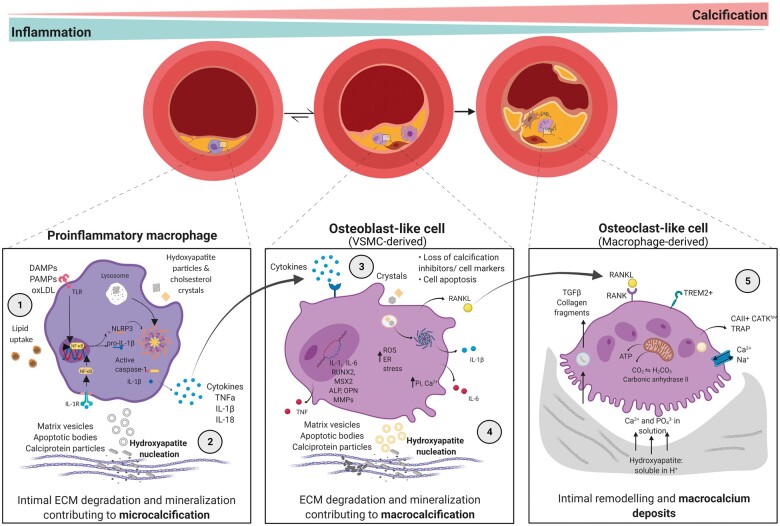Figure 1.
Interplay between macrophages and calcification in atherosclerotic plaque from early to late disease stage. Pro-inflammatory macrophages in the atherosclerotic plaque milieu undergo hydroxyapatite crystal and modified lipid uptake (1), as well as extracellular matrix vesicle and cytokine release (2). This establishes microcalcification in the plaque and induces an osteoblast-like phenotype in VSMCs (3). A pro-calcifying microenvironment and the osteochondrogenic switch of VSMCs, driven by macrophages, increase inflammatory calcification deposition and establish more densely calcified nodules (macrocalcification) (4). Macrophage engagement in the receptor activator of nuclear factor kappa B (RANK)/RANK-Ligand axis results in alternatively activated, remodelling-associated, and osteoclast-like macrophages surrounding macrocalcification deposits (5). As such, the inflammatory burden in this plaque microenvironment falls, with increased calcification and remodelling. ALP, alkaline phosphatase; ATP, adenosine triphosphate; Ca2+, calcium; CAII, carbonic anhydrase 2; CATK, cathepsin K; DAMPs, damage-associated molecular patterns; ECM, extracellular matrix; ER, endoplasmic reticulum; IL-1R, interleukin-1 receptor; IL-1β, interleukin 1 beta; IL-6, interleukin 6; IL-18: interleukin 18; MMPs, matrix metalloproteinases; MSX2, Msh Homeobox 2; NLRP3, NLR family pyrin domain containing 3; OPN, osteopontin; PAMPs, pathogen-associated molecular patterns; Pi, phosphate; ROS, reactive oxygen species; RUNX2, runt-related transcription factor 2; SASP, senescence-associated secretory phenotype; TGFβ, transforming growth factor-beta; TLRs, toll-like receptors; TNF-α, tumour necrosis factor-alpha; TRAP, tartrate resistant acid phosphatase; TREM2, triggering receptor expressed on myeloid cells 2.

